
Working data-driven is currently all the rave, for a good reason. Have you started on your journey to ensuring that your sports organization is data-driven? If not, read this post to find out why this is crucial for your sports organization. Do you know what helps you get results when working data-driven? Having Key Performance Indicators (KPIs). KPIs in sports – why do they matter? And why exactly are they so important in order to work data-driven?
Whether you use them on a daily basis or this is the first time you encounter them, Key Performance Indicators (KPIs) are something that your sports organization should include in their sports marketing strategy. But why are they so important? Well, think of it this way: not having the right KPIs in place is like going on a journey without a navigator; you are bound to get lost and not end up where you want to go.
But don’t worry, we’ve got you covered. Because in this blog post, we will be covering:
- What KPIs are
- 5 reasons why you need them to work data-driven
- 3 examples for you to steal
- Conclusion
Ready? Let’s dive right in!
Before we dive right in...
Subscribe to our blog today to ensure that you never miss valuable posts such as this one. We are passionate about helping sports organizations deliver a world-class fan experience, because better fan experience means better business. So why not use this opportunity to the fullest?

What are KPIs?
So, first things first: what exactly are KPIs?
KPI stands for Key Performance Indicator. It is a type of measurement that allows you to evaluate the success of a particular activity. For example, let’s say that your sports organization has set a goal for how much revenue they expect to make from tickets sold for a specific football match. This means that the KPIs you set will act as indicators of how well you are performing on that goal.
Basically, you can think of KPIs as milestones toward the strategic goals you are trying to achieve within your sports organization. By measuring different KPIs, you can effectively measure the success of your sports organization as a whole.
There are many different KPIs in sports that you can create based on your organization’s specific needs. But no matter what goals you are trying to achieve, big or small, one thing is certain: your KPIs need to be SMART.
The SMART criteria
If you want your KPIs in sports to be successful, then you need to ensure that they follow the SMART criteria, which stands for: Specific, Measurable, Attainable, Relevant, and Time-bound. In other words, when formulating a KPI, ask yourself the following questions:
- Is this KPI Specific enough?
- Can you actually Measure it?
- Is it realistically Attainable?
- How Relevant is the goal to your organization?
- What is the Time-frame for achieving this goal?
Setting KPIs according to this framework will make it so much easier for you to assess the performance of your different projects, as well as your sports organization as a whole. Moreover, it will make your journey to start working data-driven so much more straightforward, since you will have clearly analyzed from the start how you will measure different organizational activities.
Let’s dig a bit deeper and explore why exactly KPIs in sports are so important for the success of your sports organization.
6 reasons why tracking the right KPIs in sports matter
Let’s take a look at 6 reasons why sports organizations should set and track specific KPIs.
1. Measure your marketing targets and efforts

The first reason why tracking the right KPIs in sports matters is that this allows you to actually measure your marketing target and efforts. It might seem a bit too obvious to include this as the first reason. But, this can not be emphasized enough. Because believe it or not, a lot of organizations either skip or fail to do this step correctly.
For instance, it could tell you that you are generating only 30% of the sales target you had set from the get-go. Or, it could tell you that you sold 10% over your target goal. Whatever the case, your KPIs will let you know when things are going according to plan and when they aren’t. So thanks to your KPIs, you are given a chance to act on these insights.
By getting a clear picture of how your marketing targets and efforts are performing, you can:
- Optimize your marketing campaigns and efforts
- Maximize your marketing spend
As you can see, when done right, sports organizations can measure and follow up on specific targets that they have set up. Moreover, if things start going south, your KPIs will allow you to analyze where the gaps in your efforts might be and help you make decisions that will let you meet and even optimize your goals.
And the best part is that these results can also be analyzed in the long run…
2. Measure progress over time and find patterns

By setting clear KPIs that reflect your goals, you are not only able to measure the performance of your different goals here and now. You are also able to measure the progress of each goal over time.
Why do you want to measure KPIs in sports over time? Because by doing so, you are then able to detect whether there are certain patterns in your different numbers. For instance, over the period of 3 months, you might see spikes in sales from your online merchandise store right after a handball match that your club won. So, this number basically indicates that your sports organization will sell more merchandise right after winning a match.
To see a real-life example of this, check out PAOK’s success story below
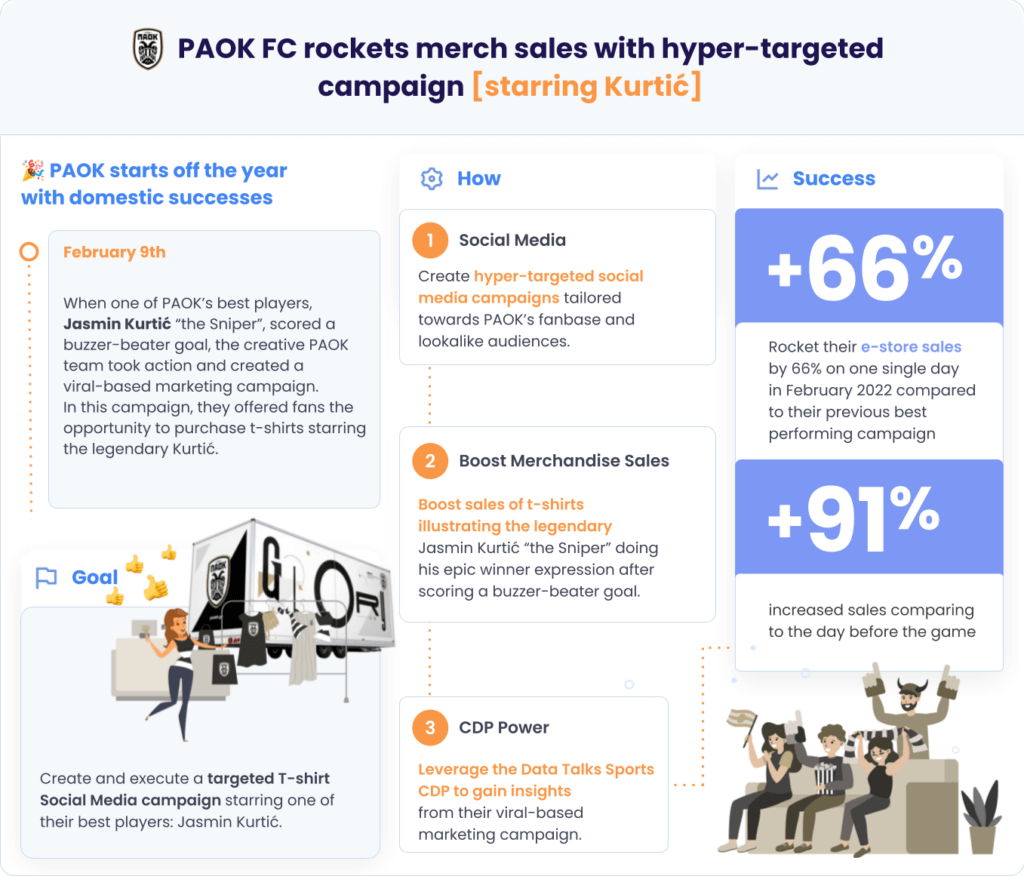
What is important to remember, though, no matter what you are measuring, is that you need to ensure that you have the necessary data at hand in order to analyze and find these patterns. Without the right data in place, you risk missing important pieces of information that can tell you why your KPIs look the way they do. Or worse, if your KPI performance plummets, you won’t know what to do in order to make it stop.
So what can you do to avoid ending up in this situation? Well, you need to…
Centralize and make your data available to everyone that needs it

Simply put, you need to unify your data and make it available to different departments and teams in your sports organization. Because having all your data available to you at all times (online as well as offline data), will make it so much easier for you to uncover relevant patterns from your data – which you can then use to adjust and optimize your strategic goals and KPIs in sports.
A Customer Data Platform (CDP) has been specifically built and designed to let you collect, analyze, and act on your data. It lets you centralize your data from all different sources, no matter whether these are online or offline. Moreover, all of this happens in real-time, meaning that the data is always up to date. So this means that you can rest assured knowing that your data is both accurate and relevant.
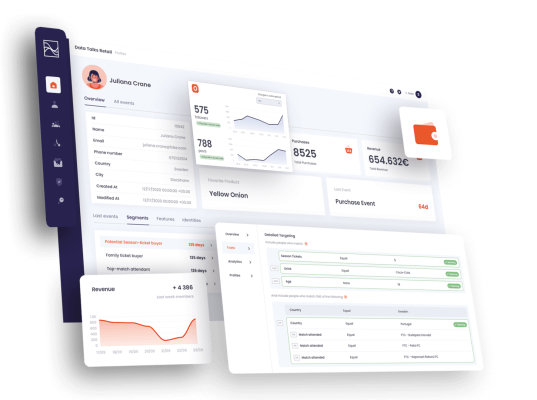
To see how this would look in action, explore the Data Talks Sports CDP demo >>
If you, however, decide to take on this challenge without the right technology in place, then it’s important to bear in mind that you might stumble upon some of the following problems:
- data stored in many different places – making it nearly impossible to get a clear picture of how you are performing on your goals.
- data in silos – having your data in silos means that you don’t have access to the data needed in order to analyze and find relevant patterns.
- obsolete data – if your data is outdated, then it’s most likely no longer useful to you.
- incomplete data – blind spots in your data due to the data being stored across different sources.
3. Better decision making
This might come as no surprise, right? By setting KPIs that reflect your strategic goals, you can make decisions that are based on real data insights that you not only can measure but also can act on.

“When you change the way you look at things, the things you look at change.”
– Dr. Wayne Dyer
Basically, setting clear KPIs is like looking through a new pair of glasses. If it is the right lens, you will be able to see clearly. So, by setting KPIs in sports that are based on real data insights and that follow the SMART criteria, you are more likely to make better and more accurate decisions.
And by making better and more accurate decisions, your sports organization can:
- Save time and resources
- Improve productivity
- Prevent mistakes and risks
- Make decisions that lead to higher revenue
But once again, this goes hand in hand with working data-driven. So having the necessary insights, and having the right technology in place, such as a Sports CDP, will let you leverage these data insights. Only then will you be able to set KPIs that will lead you toward your organization’s strategic goals and overall vision.
This brings us to another important reason to set KPIs in sports…
4. Encourage a data-driven culture
By simply setting relevant KPIs, your sports organization is now one step closer to working more data-driven. As the name suggests, a data-driven culture means that data is used to make decisions at every level of your sports organization. It basically means that you are replacing your gut feeling with real facts.
For example, if you’re a sports marketer, this means that you might make decisions based on data you have received about your fans’ characteristics, preferences, and behavior. So based on this data, you then set some strategic goals (connected to their respective KPIs). These goals could, for instance, be:
- Boosting ticket sales for a specific fan group
- Increasing your fan engagement
- Creating stronger fan loyalty
- Growing your fan base
By creating your goals based on real insights about your fans, you are now able to set goals that are actually realistic and relevant. And doing so comes with several benefits, such as:
- Creating hyper-personalized and targeted campaigns
- Much more consistent messaging
- Segmenting your audience
- Truly knowing your fans’ specific needs and desires
- Increased opportunities to up-sell and cross-sell
- Delivering a personal, relevant, and engaging fan experience
5. An integrated overview of your sports organization
As mentioned earlier in the blog post, KPIs do not only reflect the performance of individual projects; they also demonstrate how well your sports organization is performing as a whole. By measuring how well you are performing on each and every strategic goal, you can also understand whether your sports organization is headed in the right direction of meeting its mission and vision.
But then again, this is assuming that you have integrated all your data in the first place. If you are not able to integrate and unify data from your different organizational departments, then getting an overview of your sports organization will become much more difficult.
Customer Data Platforms solve this issue by collecting and centralizing your data in one place. This will allow you to uncover the insights that are relevant and necessary to understand:
- How your different teams are performing on each project
- How your overall sports organization is actually performing, letting you, in turn, identify:
- what is working
- if there are any gaps or bottlenecks
- how to best act in each case scenario
To see how a CDP does this, check out the below illustration:
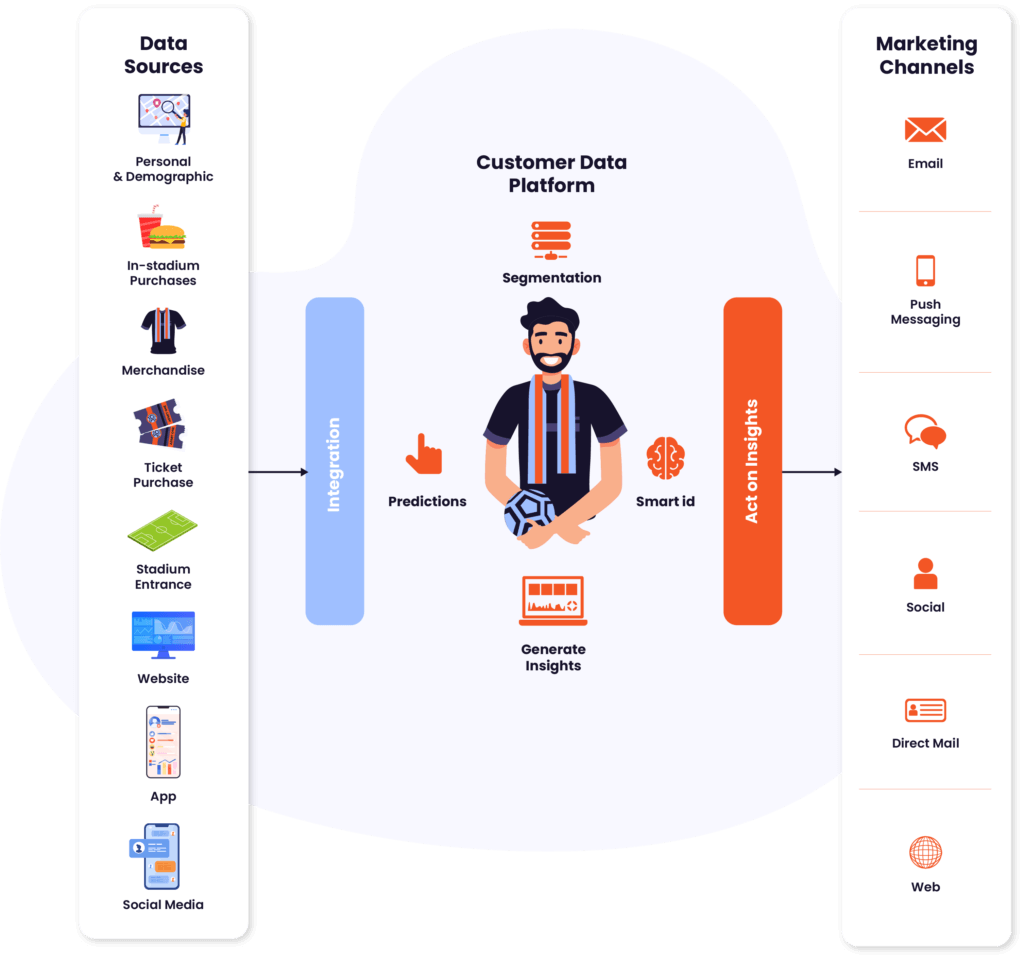
6. Uncover new revenue opportunities
As we covered up until now, measuring the right KPIs can help you gain insights and make decisions that can boost and optimize your existing revenue streams. But, did you know that these insights can also help you find new and viable revenue opportunities? That’s right!
Some of these exciting new opportunities include :
- Leveraging your own Over-the-top streaming service (OTT)
- New and valuable partnerships
- Leveraging opportunities for your women’s division
- Finding new audiences (that previously have not been observed)
- Entering the NFT market
To learn more about these amazing revenue opportunities for sports organizations, check out some of our other resources:

Why Sports Organizations need a CDP to grow and thrive

Women in sports: beyond the hashtag – time to make a difference
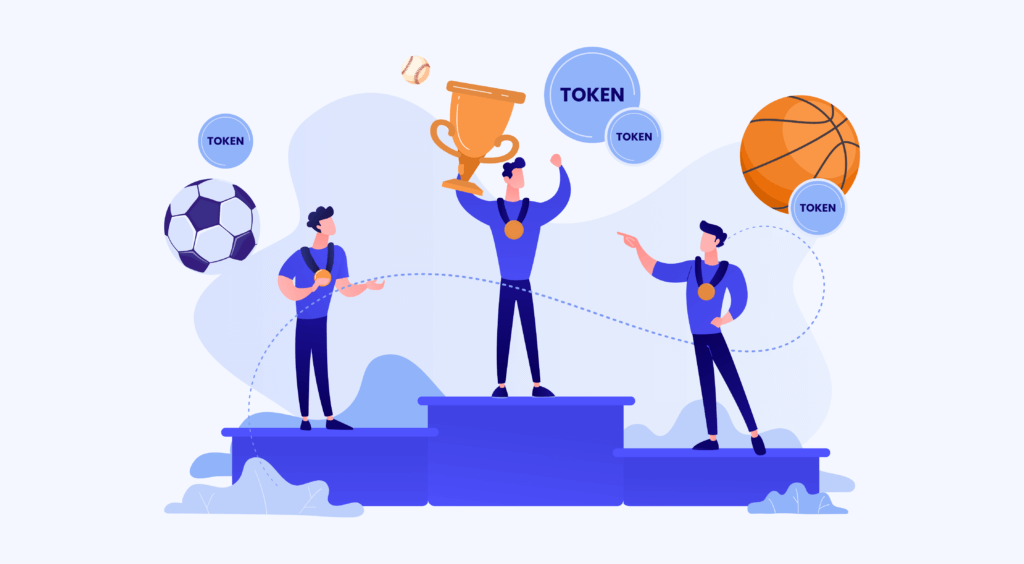
Everything You Need to Know About NFTs in Sports
3 use cases you can steal
Alright, by now you know what KPIs in sports are and why they are crucial for your sports organization. But what exactly do these KPIs in sports look like?
To help you out, here are 3 examples of KPIs in sports that you can steal here and now:
Example 1: Sports B2C:
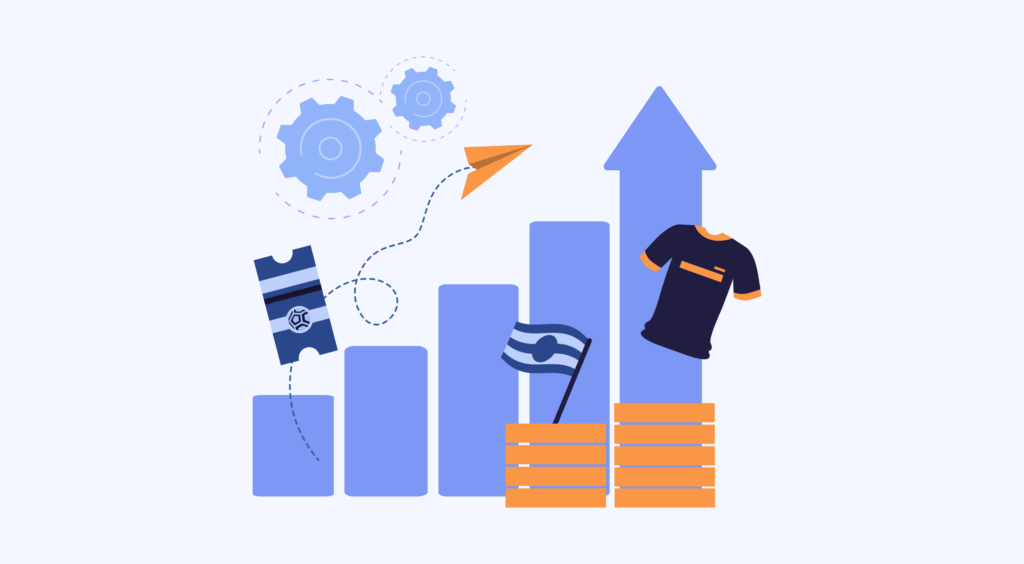
If you’re a sports organization with an online merchandise store, below are examples of KPIs that could be relevant to monitor:
- Sales
- Average order size
- Number of transactions
- Shopping cart abandonment rate
- Conversion rate
- New supporter orders vs. returning supporter orders
- Time on site
- Churn rate
- Site traffic
- Email open rate
- Net promoter score (NPS)
Example 2: Sports club

If your sports organization is, for example, a Golf club then the below KPIs could be relevant to track:
- Revenue per available tee time
- Average length of round
- Repeat business (reveals the supporter satisfaction)
- Course utilization
- Average merchandise sale per supporter
- Average food and beverage sales per supporter
- Percentage of golfers who purchase lessons
Example 3: Sports B2B

If you are a sports organization that wants to boost the sponsorship value of your partners, then these are some of the KPIs you will want to monitor:
- Increased revenue for partner
- Share of audience reached
- Conversion
- Click-through-rate to website
- Reach
- Increased brand awareness
- Engagement
- Impression count
These KPIs are of course just scratching the surface of what you can measure. But as you can see, there are so many possible things for you to measure and help your sports organization understand:
- How well you are performing on your different goals
- How your sports organization is performing as a whole
- And what opportunities you can explore and leverage when measuring your KPIs over time
Next steps
In this blog post, we have covered:
- What KPIs are
- Why sports organizations should care about KPIs
- And 3 examples that you take as they are and implement today
However, having all your data collected and centralized in one place is not just recommended to effectively measure and act on your KPIs – it is necessary. By having the right technology in place, such as a Sports CDP, you will be able to set KPIs that are both realistic and relevant to your specific goals.
Of course, explaining this in simple text is not enough to show you how powerful a CDP is. So, we created a free demo to let you see how exactly all this would look in action.
Because, after all, a picture is worth more than a thousand words, right?

Leave a Reply